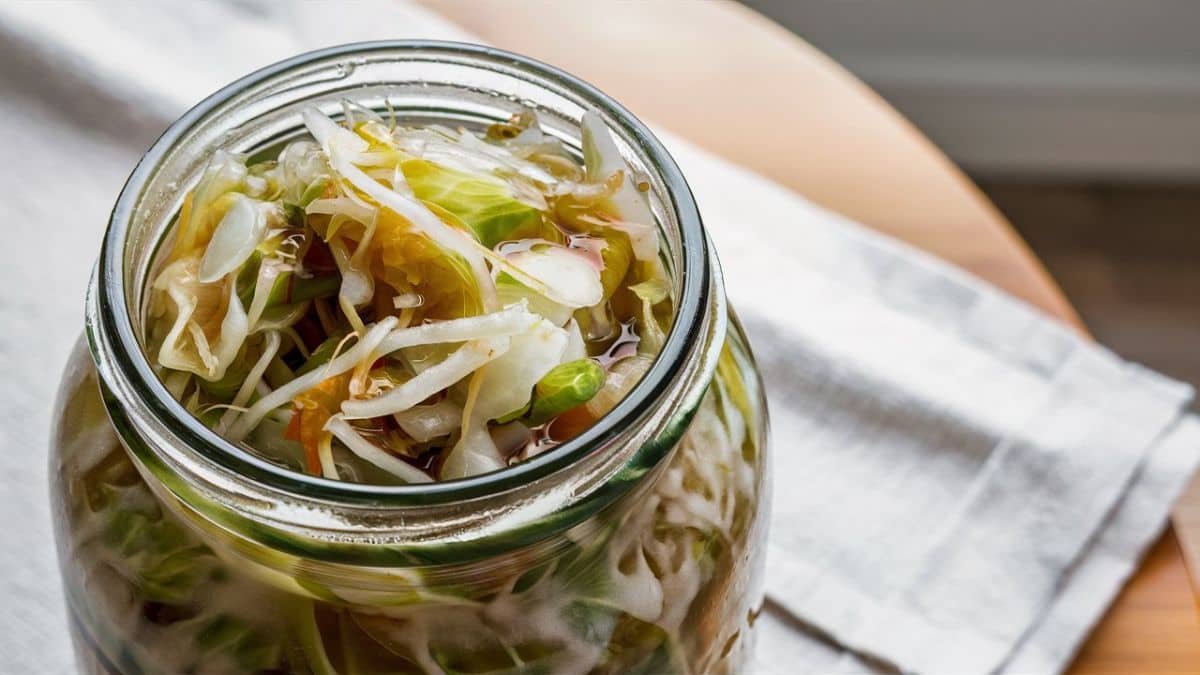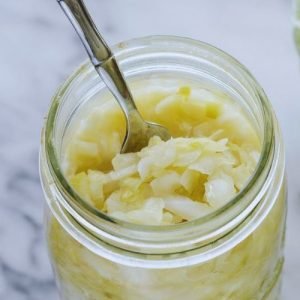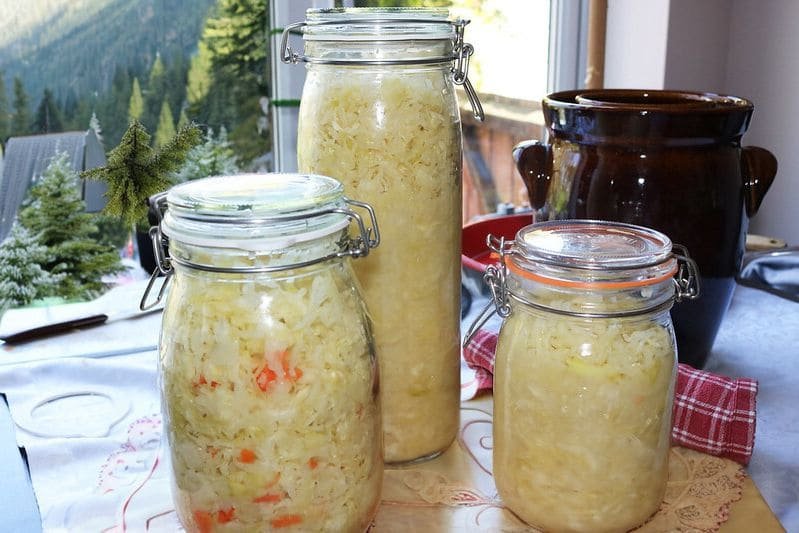How To Make Fermented Cabbage (Sauerkraut Recipe)

Fermented foods have a rich history and are incredibly beneficial for gut health. One of the most popular fermented foods is sauerkraut. Making your own sauerkraut is simple and requires only a few ingredients.
Let’s dive into the details of how to make this traditional dish.

Fermented Cabbage (Sauerkraut)
Equipment
- 1 Cutting Board
- 1 Sharp knife
- 1 Large mixing bowl
- 1 Quart-sized wide-mouth mason jar
- 1 weight (to keep cabbage submerged)
- 1 Cheesecloth or clean kitchen towel
Ingredients
- 1 medium head green cabbage (about 2 pounds)
- 3 tbsp sea salt
- 1 tsp Caraway seeds (optional)
- 1 tsp peppercorns (optional)
Instructions
- Clean all equipment thoroughly.
- Remove any wilted or discolored outer leaves from the cabbage.
- Cut the cabbage into quarters, remove the core, and thinly slice the cabbage.
- Place the sliced cabbage in the large mixing bowl
- Sprinkle the salt over the cabbage and massage it with clean hands for about 5 minutes until the cabbage becomes soft and releases its liquid.
- Add the Caraway seeds and the peppercorns.
- Pack the cabbage and its liquid tightly into the quart-sized mason jar, leaving about 1 inch of headspace at the top.
- Place the weight on top of the cabbage to keep it submerged under the liquid.
- Cover the jar with cheesecloth or a clean kitchen towel and secure it with a rubber band.
- Let the jar sit at room temperature (60-75°F) for around 2 weeks. Check the sauerkraut daily, pressing down on the weight to keep the cabbage submerged. Skim off any scum that may form on the surface.
- Taste the sauerkraut after 1 week and continue fermenting until it reaches your desired level of tanginess.
- Once the sauerkraut is ready, remove the weight and cheesecloth, seal the jar with a lid, and store it in the refrigerator. The sauerkraut will keep for several months.
Notes
- Use fresh, firm cabbage for best results.
- Keep the cabbage submerged under the brine to prevent mold growth.
- If scum forms on the surface during fermentation, simply skim it off.
- Fermentation time may vary depending on room temperature and personal taste preferences.
- Homemade sauerkraut is a great source of probiotics and vitamin C.
- You can buy this 4-Pack of Fermentation Glass Weights with Easy Grip Handle for Wide Mouth Mason Jars from Amazon.
- You can also buy this 2 pack Jillmo Fermentation Kit. It includes 2 x 1.5 Liter fermentation jars with fermenting weights and airlocks.
What are some common mistakes to avoid?
Making sauerkraut at home can be fun, but there are some common mistakes to avoid.
- First, use the right salt. Sea salt or pickling salt works best because iodized salt or salt with additives can mess up the fermentation process.
- Keep the cabbage submerged. It’s also crucial to keep the cabbage submerged in its brine to prevent mold. Use a weight or a smaller jar to press the cabbage down and check it daily.
- Choose fresh, firm cabbage heads. Old or damaged cabbage can spoil the flavor.
- Clean your equipment. Clean all your equipment thoroughly before you start. Dirty jars or utensils can contaminate your sauerkraut.
- Temperature. The temperature where you ferment your sauerkraut matters. It should be between 60-75°F (15-24°C). Too hot or too cold and the fermentation may not work right.
- Taste your sauerkraut every few days. This helps you know when it’s tangy enough for your liking. Letting it ferment too long can make it too sour or mushy.
- Finally, be patient. Sauerkraut can take 1-4 weeks to ferment. It usually takes 2 weeks. If it needs more, don’t give up.
By avoiding these common mistakes, you’ll make delicious, healthy homemade sauerkraut.
Can You add spices to your sauerkraut?
Of course you can.. You can add spices to your sauerkraut to enhance its flavor. Some of my personal favorite choices are:
- Caraway Seeds: A traditional choice for sauerkraut. Add a handful during the massaging stage to let the aroma permeate through the cabbage.
- Juniper Berries: These bring a slight pine-like flavor with hints of pepper and fruit. Use them dried or fresh. You can leave them whole or crush them for more intensity.
- Dill: Fresh or dried dill works well. For a stronger flavor, use dill seeds.
- Turmeric: This spice gives your sauerkraut a golden color and adds health benefits. Grate fresh turmeric or use powdered. Keep in mind, turmeric has a strong taste, so use it sparingly.
- Other Spices and Herbs: Feel free to experiment with spices like black peppercorns, fennel seeds, paprika, coriander, mustard seeds, ginger, garlic, cumin, cinnamon, and star anise.
TIPS:
- Spices will get stronger as the sauerkraut ferments.
- Refer to a book like “The Flavor Bible” for ideas on which spices go well together.
Should you add vinegar to your Sauerkraut?
When making sauerkraut, the question of whether to add vinegar often comes up. According to Holly Howe from makesauerkraut.com, it’s generally not recommended to add vinegar during the fermentation process.
Vinegar can interfere with the natural growth of beneficial lactic-acid bacteria, which are crucial for proper fermentation.
This can lead to off-textures, strange flavors, and a decrease in the natural preservative qualities of lacto-fermentation.
Vinegar-based sauerkraut, like many store-bought brands, may taste sour but lacks the beneficial bacteria and enzymes that naturally fermented sauerkraut offers.
Miro Stefanov from fermentmakers.com provides a more nuanced perspective. Adding a small amount of vinegar (no more than 1 teaspoon per quart) at the start might help create a slightly more acidic environment without disrupting the process.
But using too much vinegar can pickle the cabbage instead of fermenting it, disrupting the natural succession of lactic-acid bacteria crucial for fermentation. This succession involves different strains of bacteria that thrive at different pH levels, starting at a higher pH and gradually lowering as the fermentation progresses.
During fermentation, adding vinegar can still interfere with this natural bacterial growth, regardless of how many days it has been fermenting. Even a small amount can alter the pH balance, negatively impacting the flavor and the variety of beneficial bacteria.
The best time to add vinegar, if you desire its tangy flavor, is after the fermentation is complete. This way, the fermentation process remains untouched, and you still get the added tanginess without disrupting the beneficial bacteria.
For those who want extra tang without vinegar, consider adding apples or cranberries to your sauerkraut or using sweeter cabbage varieties. These options can naturally enhance the flavor without compromising the fermentation process.
In my opinion, sticking to the traditional method of using just cabbage, salt, and perhaps some spices or other vegetables will yield the best results. This allows the natural lactic-acid bacteria to thrive, creating a probiotic-rich, naturally tangy sauerkraut.
Can you reuse the brine from homemade sauerkraut?

Reusing the brine from your homemade sauerkraut is definitely an option. The brine contains beneficial bacteria and lactic acid, which can help jumpstart the fermentation of a new batch of sauerkraut. When reusing brine, ensure it’s from a successful, mold-free batch to avoid contamination.
Adding a bit of fresh salt and water to the old brine can help maintain the right conditions for fermentation.
Another great use for leftover sauerkraut brine is as a starter for other fermented vegetables. The brine’s live cultures can aid in fermenting carrots, cucumbers, or beets, giving you delicious and probiotic-rich veggies.
If you’re looking to get creative in the kitchen, the brine can be used in salad dressings and marinades. That’s one of my personal favorites. Its tangy, salty flavor adds a unique twist to your dishes. Mix it with olive oil, herbs, and spices for a zesty dressing, or use it to marinate meats and tofu, infusing them with a burst of flavor.
The brine is also great for soup bases. Adding a splash to soups and stews can enhance their depth of flavor. Just be mindful of the salt content, as the brine can be quite salty.
For a refreshing twist, try using the brine in cocktails. A splash of sauerkraut brine can elevate your Bloody Mary or even a simple vodka tonic, offering a savory and tangy note.
So yes, you can definitely reuse the brine from your homemade sauerkraut. With a bit of creativity, it can add flavor and probiotics to a variety of dishes, making it a versatile ingredient in your kitchen.
☝️ If you’re curious about the many benefits of pickle juice, I highly recommend checking out our article on 20 Unexpected Pickle Juice Benefits And Uses You Probably Didn’t Know. You’ll discover new and exciting ways to make the most of every drop.
What are the health benefits of sauerkraut?
Sauerkraut offers some notable health benefits, making it a valuable addition to your diet. Its nutritional content includes fiber, vitamins, and minerals such as vitamin C, vitamin K1, iron, folate, manganese, copper, and potassium.
Here’s a table with the most notable nutrients 100 grams of a typical canned, store-bought sauerkraut has:
| Nutrient | Value | RDI (%)* |
| Vitamin B6 | 0,13 mg | 10% |
| Vitamin C | 14.7 mg | 16.3% |
| Vitamin K | 13 μg | 11% |
| Fiber | 2.9 g | 7.63% |
| Copper | 0.096 mg | 10.7% |
| Iron | 1.47 mg | 18.4% |
| Manganese | 0.15 mg | 6.57% |
| Sodium | 661 mg | 44% |
*RDI of a 19 – 50 year old man.
- Improves Digestion – Sauerkraut is rich in fiber, aiding digestion and promoting regular bowel movements. It contains probiotics, which improve gut health by balancing gut flora, enhancing digestive efficiency (WebMD).
- Promotes Weight Loss – Low in calories and high in fiber, sauerkraut helps you feel full longer, aiding weight management. Probiotics in sauerkraut may reduce fat absorption (WebMD).
- Boosts Immunity – Fermentation increases nutrient levels, making sauerkraut a good source of probiotics that strengthen the immune system. A healthy gut boosts overall immune response (Healthline).
- Anti-Inflammatory and Antioxidant Properties – Sauerkraut may offer anti-inflammatory and antioxidant benefits, supporting gut health and potentially reducing the risk of chronic diseases and certain cancers (Healthline).
☝️ Keep in mind that due to its high sodium content, you should eat sauerkraut in moderation.
Is homemade sauerkraut better than store-bought?
Yes, homemade sauerkraut is often considered better than store-bought for several reasons:
- Ingredients: Homemade sauerkraut is generally made with cabbage and salt, while store-bought sauerkraut may contain additional ingredients such as preservatives or added sugars. These additional ingredients can affect the nutritional value of sauerkraut.
- Preparation Methods: Homemade sauerkraut is traditionally made through lacto-fermentation, a natural fermentation process. Some store-bought sauerkraut may be vinegared or fermented using starter cultures.
- Nutritional Values: Homemade sauerkraut is likely to have more beneficial bacteria or probiotics than store-bought sauerkraut. This is because homemade sauerkraut is rarely heated or pasteurized, which means it retains more of the beneficial bacteria and nutrients.
- Taste and Texture: Homemade sauerkraut tends to have a crunchier texture and more complex flavor than store-bought sauerkraut.
- Cost: Making your own sauerkraut can be more cost-effective. For example, if you made your own sauerkraut using organic ingredients, it would cost less than $3 for 32 ounces, whereas a jar of organic store-bought kraut costs almost twice as much for half the amount.
How long does homemade sauerkraut can last?
Homemade sauerkraut can last for a significant amount of time when stored properly:
- At Room Temperature: If not refrigerated, homemade sauerkraut should be consumed within a month of opening1.
- Refrigeration: Once the fermentation is complete, the sauerkraut can be moved to the refrigerator. When properly refrigerated, sauerkraut will remain good for at least several months. Some sources suggest that properly fermented and stored sauerkraut in a refrigerator at 35 degrees F can last for a couple of years without going bad.
- Freezing: For long-term storage, sauerkraut can be frozen and it will stay good for at least 12 to 24+ months.
- Canning: If canned, sauerkraut remains good for at least 12 to 18 months.
☝️ Remember, it’s important to keep the sauerkraut airtight to prevent oxygen exposure. The amount of cabbage and other ingredients in relation to the amount of salt is also important when it comes to storage and preventing fermentation failures.
Final Words
There you have it.. I believe I’ve covered all things related to making fermented cabbage at home. If not, feel free to live your question down below and let’s start the conversation. Also, feel free to check our recipe section for more fermented recipes.
In the meantime, I leave you with some of my favorite fermented recipes posted on FoodNourish.


